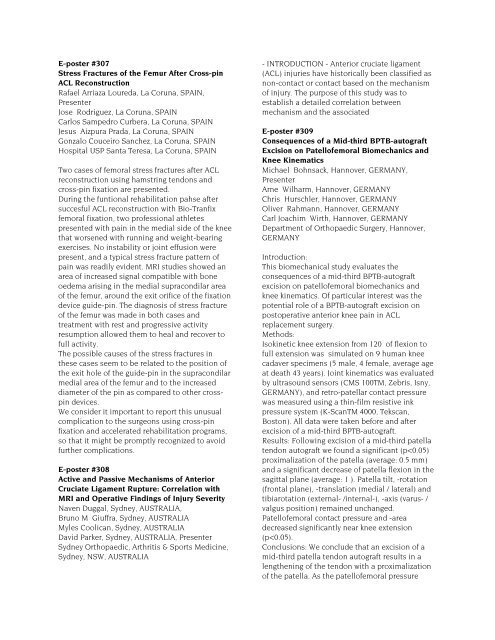POSTER ABSTRACTS - ISAKOS
POSTER ABSTRACTS - ISAKOS
POSTER ABSTRACTS - ISAKOS
Create successful ePaper yourself
Turn your PDF publications into a flip-book with our unique Google optimized e-Paper software.
E-poster #307<br />
Stress Fractures of the Femur After Cross-pin<br />
ACL Reconstruction<br />
Rafael Arriaza Loureda, La Coruna, SPAIN,<br />
Presenter<br />
Jose Rodriguez, La Coruna, SPAIN<br />
Carlos Sampedro Curbera, La Coruna, SPAIN<br />
Jesus Aizpura Prada, La Coruna, SPAIN<br />
Gonzalo Couceiro Sanchez, La Coruna, SPAIN<br />
Hospital USP Santa Teresa, La Coruna, SPAIN<br />
Two cases of femoral stress fractures after ACL<br />
reconstruction using hamstring tendons and<br />
cross-pin fixation are presented.<br />
During the funtional rehabilitation pahse after<br />
succesful ACL reconstruction with Bio-Tranfix<br />
femoral fixation, two professional athletes<br />
presented with pain in the medial side of the knee<br />
that worsened with running and weight-bearing<br />
exercises. No instability or joint effusion were<br />
present, and a typical stress fracture pattern of<br />
pain was readily evident. MRI studies showed an<br />
area of increased signal compatible with bone<br />
oedema arising in the medial supracondilar area<br />
of the femur, around the exit orifice of the fixation<br />
device guide-pin. The diagnosis of stress fracture<br />
of the femur was made in both cases and<br />
treatment with rest and progressive activity<br />
resumption allowed them to heal and recover to<br />
full activity.<br />
The possible causes of the stress fractures in<br />
these cases seem to be related to the position of<br />
the exit hole of the guide-pin in the supracondilar<br />
medial area of the femur and to the increased<br />
diameter of the pin as compared to other crosspin<br />
devices.<br />
We consider it important to report this unusual<br />
complication to the surgeons using cross-pin<br />
fixation and accelerated rehabilitation programs,<br />
so that it might be promptly recognized to avoid<br />
further complications.<br />
E-poster #308<br />
Active and Passive Mechanisms of Anterior<br />
Cruciate Ligament Rupture: Correlation with<br />
MRI and Operative Findings of Injury Severity<br />
Naven Duggal, Sydney, AUSTRALIA,<br />
Bruno M Giuffra, Sydney, AUSTRALIA<br />
Myles Coolican, Sydney, AUSTRALIA<br />
David Parker, Sydney, AUSTRALIA, Presenter<br />
Sydney Orthopaedic, Arthritis & Sports Medicine,<br />
Sydney, NSW, AUSTRALIA<br />
- INTRODUCTION - Anterior cruciate ligament<br />
(ACL) injuries have historically been classified as<br />
non-contact or contact based on the mechanism<br />
of injury. The purpose of this study was to<br />
establish a detailed correlation between<br />
mechanism and the associated<br />
E-poster #309<br />
Consequences of a Mid-third BPTB-autograft<br />
Excision on Patellofemoral Biomechanics and<br />
Knee Kinematics<br />
Michael Bohnsack, Hannover, GERMANY,<br />
Presenter<br />
Arne Wilharm, Hannover, GERMANY<br />
Chris Hurschler, Hannover, GERMANY<br />
Oliver Rahmann, Hannover, GERMANY<br />
Carl Joachim Wirth, Hannover, GERMANY<br />
Department of Orthopaedic Surgery, Hannover,<br />
GERMANY<br />
Introduction:<br />
This biomechanical study evaluates the<br />
consequences of a mid-third BPTB-autograft<br />
excision on patellofemoral biomechanics and<br />
knee kinematics. Of particular interest was the<br />
potential role of a BPTB-autograft excision on<br />
postoperative anterior knee pain in ACL<br />
replacement surgery.<br />
Methods:<br />
Isokinetic knee extension from 120 of flexion to<br />
full extension was simulated on 9 human knee<br />
cadaver specimens (5 male, 4 female, average age<br />
at death 43 years). Joint kinematics was evaluated<br />
by ultrasound sensors (CMS 100TM, Zebris, Isny,<br />
GERMANY), and retro-patellar contact pressure<br />
was measured using a thin-film resistive ink<br />
pressure system (K-ScanTM 4000, Tekscan,<br />
Boston). All data were taken before and after<br />
excision of a mid-third BPTB-autograft.<br />
Results: Following excision of a mid-third patella<br />
tendon autograft we found a significant (p
















